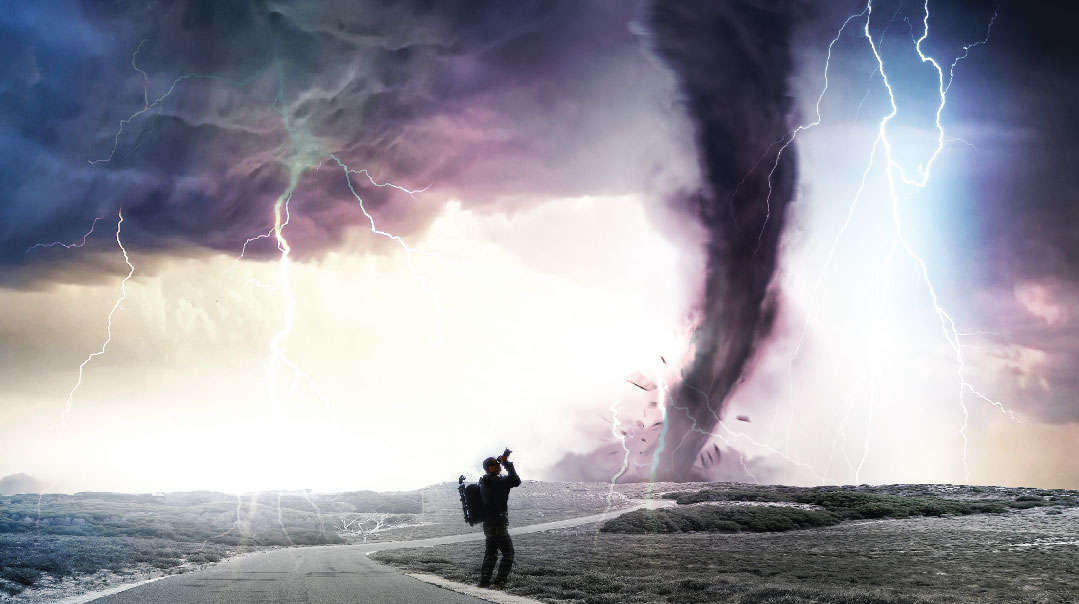In the Eye of the Storm
| November 13, 2019Meet the storm chasers

When the sky gets dark and wild clouds begin to race across the horizon, most people start running in the opposite direction. After all, tornadoes and lightning storms are no joke; they claim the lives of many people each year.
Incredibly, however, while almost everyone is hurriedly packing their car to leave town before the storm hits, a small group of adventurers are heading directly toward the storm — armed with nothing more than cameras and radars, and utterly defenseless against the storm’s wrath.
Meet the storm chasers.
The First Storm Chaser
The father of the storm-chasing movement was David Hoadley (born 1938), the founder of StormTrack magazine. Hoadley began chasing storms in 1956 in his home state of North Dakota. However, storm chasing only gained widespread popularity with a man named Neil B. Ward (1914–1972), who, beginning in 1961, used the Oklahoma Highway Patrol radio to help him track and study storms.
The first coordinated group storm chase was organized in 1969 by the Alberta Hail Project, a research project looking for ways to suppress hail. The project involved then-state-of-the-art meteorological equipment attached to rugged vehicles and nifty contraptions specially built on the fronts of vehicles to catch the rock-hard balls of hail often seen during a storm. Operators at a radar site directed the storm chasers right into the heart of a ferocious thunderstorm. The operation was a success and a new era had dawned for storm chasers around the world.
A Dangerous Obsession
Storm chasing is not usually a paid job. They chase storms either to experience the incredible adrenaline rush of photographing monstrous storms as they bear down on them, or sometimes to learn more about the scientific aspects of storms and how they can be predicted. Whatever the reason, it’s a dangerous job requiring nerves of steel.
Every storm chaser knows that the next storm could be his last. They risk being killed by huge balls of hail, tornadoes, flooding, roadways covered with downed power lines, winds fast enough to blow a cow through the air, and many other hazards.
Luckily, storm chasers are usually quite knowledgeable besides being adventurous. They understand the behavior of tornadoes and know how far to stay away from cyclones, where a storm is likely to head next, and other such life-preserving information. They also know that chasing a storm at night, when all their knowledge is useless because they cannot see the storm moving clearly, is tantamount to suicide.
It is because of their experience and knowledge that most storm chaser deaths aren’t directly caused by storms. The biggest hazard, which has claimed the lives of many storm chasers is driving. During a storm, the roads near the area are usually filled with animals that have been displaced from their farms and pastures. Driving on streets strewn with debris, fog, and wandering cows is a recipe for a terrible accident.
It’s dangerous enough driving on the road during a storm; now imagine having to keep an eye on the road while scanning the sky for storm activity, checking weather data, communicating with fellow chasers over the radio, and making sure to document your adventure via photos or videos.
The key to survival is to proceed with extreme caution during the entire ride. Often, a storm chaser must battle the urge to drive just a little bit more, even when he has been chasing the storm for the entire day. Also, because many storm chases are documented and uploaded for people to enjoy, storm chasers feel pressured to make the chase even more exciting by leaving their cars and walking very close to the heart of the storm. With each death-defying feat, storm chasers compete with each other, attempting to outdo their peers.
(Excerpted from Mishpacha Jr., Issue 785)
Oops! We could not locate your form.






